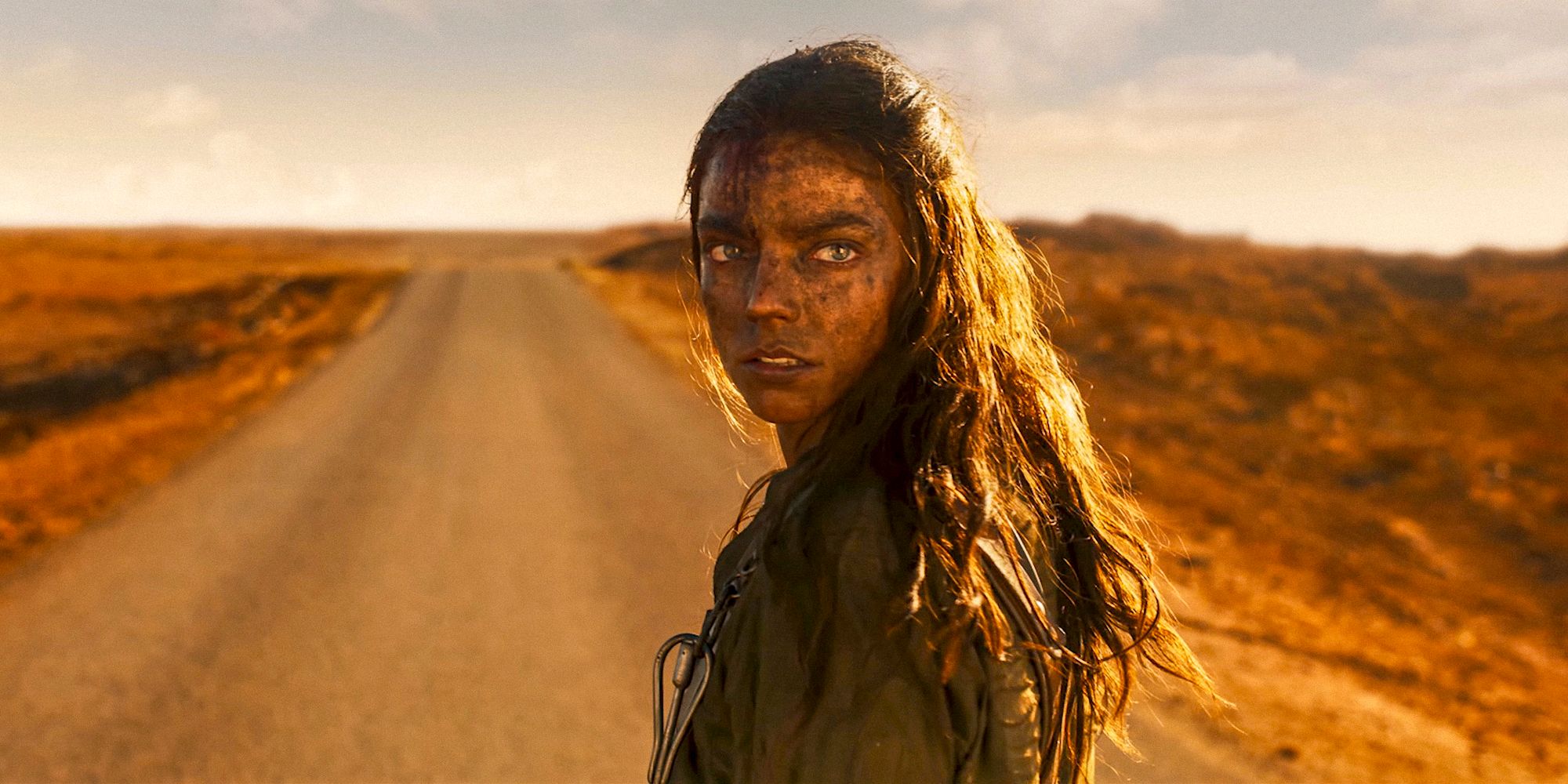
Director: George Miller
Stars: Anya Taylor-Joy, Chris Hemsworth, Tom Burke
Catapulting the back-and-forth stunt chain of Buster Keaton’s The General into an Antipodean post-apocalyptic wasteland, George Miller exploded the boundaries of his own mythic saga in 2015 with Mad Max: Fury Road; a breathless chase movie 30 years in the making. Justly held up on arrival as one of the greatest action movies ever made, Fury Road won the public hearts and swept-up technical at the Oscars, securing it’s place in Valhalla as a modern classic. As unlikely a follow-up as it was to the Mel Gibson movies that preceded it, it’s prequel, Furiosa – A Mad Max Saga, feels even more foolhardy. How do you improve on something that’s become thought of as a benchmark work?
The answer to that question is by doing something else.
Even from it’s very beginning – amid the verdant vistas of the utopian Green Place – one can tell immediately that we’re back in Miller’s world. Once we burst out of the thin vein of forestry back into the sun-blasted deserts of Miller’s dry-heat dystopia, there’s no question. But narratively speaking, this is something more ambitious than the streamlined exuberance of Fury Road.
Set over years instead of days, Furiosa is an almost Tarantino-esque slow-burn revenge tale, building from laborious, hog-wild fragments, coalescing with groaning inevitability as it chugs toward it’s Leone-sized payoff. On his introduction for the special edition cut of Aliens, James Cameron calls that film “40 miles of bad road”, evoking the sense of tough endurance felt while watching (and probably making) the longer version of the movie. “40 miles of bad road” is exactly how Furiosa feels. It can be hard going. You might feel every bump along the way. But the destination is surely worth it.
Anya Taylor-Joy takes the reins portraying the younger version of Charlize Theron’s iconic Imperator, but we don’t see her for the first hour. Instead we’re in the company of Furiosa’s juvenile self, played with stoic force by young Alyla Browne. Captured by goons working for the absurd, dastardly hooligan Dementus (an on-fire Chris Hemsworth), Furiosa refuses to give up the location of her origins, a place of mythic abundance that pivots Dementus’ attention… until he stumbles upon more immediate possibilities. Lured into the vicinity of The Citadel, Dementus reveals his bolshy opportunist’s temperament, scrabbling to lay claim to whichever of the region’s great empires he can. If that means trading the young girl he’s stumbled upon on his travels, so be it.
If you’re rocking up expecting the same propulsive action storytelling, you’re probably setting yourself up for disappointment. Furiosa is about context. It’s about fleshing out a world we previously only dashed through. The key word in the title might not be it’s heroine’s name, but the word “Saga”. This is a different story within the same milieu, and as such it requires a different method of telling.

So it’s episodic, it’s comparatively patient. Like Furiosa herself, it broods. But Miller also appreciates that he has a larger audience than ever with certain expectations. And when he sates our appetites he’s like Immortan Joe showering us with torrents of water, letting us gorge ourselves. The action set pieces in Furiosa are fewer and further between, but they’re spectacles to match the ratatat sections that bumped into one another on Fury Road. Our first serious time spent in Taylor-Joy’s company in the chapter “The Stowaway” ticks all those nostalgia boxes and then some, adding wild parachutists into Miller’s already-crazed arsenal of desert warriors. Here, too, we get to bed in with Tom Burke’s smouldering Praetorian Jack, a potential champion for Furiosa and the first person in this world to treat her like an equal.
Furiosa does fan service extremely well, particularly by allowing us to visit places we previously only heard about. So it’s time to tour Gas Town and the Bullet Farm. The latter becomes the stage for the film’s other great action throw-down; all snipers and crashing masonry. Here Miller flexes to show his ingenuity isn’t solely related to trucks and bikes, though this bravura section of the film does lead us into its most overtly thrilling chase sequence. The orchestration is as impressive as anything we’ve seen before, but its nestled within something meatier, crueller, heavier with loss and waiting.
While it’s hero remains mostly mute in a great tradition of cinematic avenging angels, Furiosa is wordier than any other Mad Max film and it serves as a smart and welcome reminder that Miller is great at dialogue. For all it’s show-don’t-say mastery, Fury Road is memorable when it speaks. Furiosa is downright impressive whenever mouths are opened. This is particularly true when it comes to one final showdown where Hemsworth – for all his pantomime largess – eats up the script with a tenacity we’ve rarely seen from him of late. It’s his best work.
With an ending so well-written, so well-seeded (you’ll pardon the pun once you’ve seen it), first-hour grumbles and complaints become lost in the rear view mirror. I get the strong feeling that, knowing the shape of the whole, re-watches will be much kinder to the film’s early chapters, which largely feel unmoored from expectation. What’s left to set aside is Miller’s more abundant use of green screen this outing to composite images onto his widescreen canvas. If it feels a shade clunkier than we’re used to, consider that it also cultivates a unique visual tone that sets Furiosa apart from its identikit Hollywood brethren.
Because it is different. Miller’s mad, mad, mad, mad world comes from the darkly comic, rugged and grotesque voids of Australian madness and camaraderie. These movies are intrinsically Australian and exist within a modestly-sized but powerful lineage of Ozzie westerns that reflect the seismic effect such wastelands have on the human psyche. It’s a different sensibility to Hollywood storytelling, even if its influenced by it to certain degrees. So, yes, there’s even a place for the ungainly in Furiosa‘s approach to visual effects (let’s not forget Fury Road‘s uglier tendencies for purposes of 3D now thankfully no longer required).
And if you’re a stickler on that point, consider that you may be overlooking the combined efforts of so many other departments, from Miller as co-ordinator down through costuming, hair, make-up, stunt works and the gargantuan array of props, motor vehicles and set decoration corralled for this new and vivid mythology.
Imagine a footnote longer and richer than the point it is expanding. That is how Furiosa anecdotally improves the existing text.
As with Aliens, this is 40 miles of bad road worth traversing again and again.


An insightful review. I recently had an opportunity to watch this movie and enjoyed it. I thought it was a fantastic origin story for a famous feminist character. I also preferred it to “Fury Road”, which I consider highly overrated.
Here’s my thoughts on “Fury Road”: